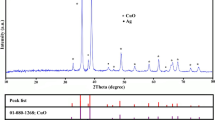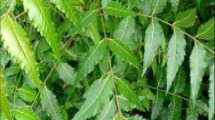Abstract
Mosquitoes transmit serious human diseases, causing millions of deaths every year. The use of synthetic insecticides to control vector mosquitoes has caused physiological resistance and adverse environmental effects in addition to high operational cost. Insecticides synthesized of natural products for vector control have been a priority in this area. In the present study, silver nanoparticles (Ag NPs) were green-synthesized using a floral extract of Chrysanthemum indicum screened for larvicidal and pupicidal activity against the first to fourth instar larvae and pupae of the malaria vector Anopheles stephensi mosquitoes. The synthesized Ag NPs were characterized by using UV–vis absorption, X-ray diffraction, transmission electron microscopy, and energy-dispersive X-ray spectroscopy techniques. The textures of the yielded Ag NPs were found to be spherical and polydispersed with a mean size in the range of 25–59 nm. Larvae and pupae were exposed to various concentrations of aqueous extract of C. indicum and synthesized Ag NPs for 24 h, and the maximum mortality was observed from the synthesized Ag NPs against the vector A. stephensi (LC50 = 5.07, 10.35, 14.19, 22.81, and 35.05 ppm; LC90 = 29.18, 47.15, 65.53, 87.96, and 115.05 ppm). These results suggest that the synthesized Ag NPs have the potential to be used as an ideal eco-friendly approach for the control of A. stephensi. Additionally, this study provides the larvicidal and pupicidal properties of green-synthesized Ag NPs with the floral extract of C. indicum against vector mosquito species from the geographical location of India.




Similar content being viewed by others
References
Abbott WS (1925) A method of computing the effectiveness of an insecticide. J Econ Entomol 18:265–267
Alder HL, Rossler EB (1977) Introduction to probability and statistics. Freeman, San Francisco, 246p
Awwad AM, Salem NM, Abdeen AO (2013) Green synthesis of silver nanoparticles using carob leaf extract and its antibacterial activity. Int J Ind Chem 4:29
Burda C, Chen X, Narayanan R, El-Sayed MA (2005) The chemistry and properties of nanocrystals of different shapes. Chem Rev 105:1025–1102
Chapagain BP, Saharan V, Wiesman Z (2008) Larvicidal activity of saponins from Balanites aegyptiaca callus against Aedes aegypti mosquito. Bioresour Technol 99:1165–1168
Debnath T, Jin HL, Hasnat MA, Kim Y, Samad NB, Park PJ, Lim BO (2013) Antioxidant potential and oxidative DNA damage preventive activity of Chrysanthemum indicum. J Food Biochem 37:440--448
Edeoga HO, Okwu DE, Mbaebie BO (2005) Phytochemical constituents of some Nigerian medicinal plants. Afr J Biotechnol 4:685–688
Finney DJ (1971) Probit analysis. Cambridge University Press, London
Huang J, Li Q, Sun D, Lu Y, Su Y, Yang X, Wang H, Wang Y, Shao W, He N, Hong J, Chen C (2007) Biosynthesis of silver and gold nanoparticles by novel sundried Cinnamomum camphora leaf. Nanotechnology 18:105104
Jang YS, Kim MK, Ahn YJ, Lee HS (2002) Larvicidal activity of Brazilian plants against Aedes aegypti and Culex pipienspallens (Diptera: Culicidae). Agric Chem Biotechnol 45:131–134
Jha AK, Prasad K, Kulkarni AR (2009) Plant system: nature’s nanofactory. Colloids Surf B: Biointerfaces 73:219–223
Jung EK (2009) Chemical composition and antimicrobial activity of the essential oil of Chrysanthemum indicum against oral bacteria. J Bacteriol Virol 19:61–69
Kesharwani J, Yoon KY, Hwang J, Rai M (2009) Phytofabrication of silver nanoparticles by leaf extract of Datura metel: hypothetical mechanism involved in synthesis. J Bionanoscience 3:39–44
Kovendan K, Murugan K, Vincent S (2012) Evaluation of larvicidal activity of Acalypha alnifolia Klein ex Willd. (Euphorbiaceae) leaf extract against the malarial vector, Anopheles stephensi, dengue vector, Aedes aegypti and Bancroftian filariasis vector, Culex quinquefasciatus (Diptera: Culicidae). Parasitol Res 110:571–581
Kumar A, Singh SP, Bhakuni RS (2005) Secondary metabolites of Chrysanthemum genus and their biological activities. Curr Sci 89:1489–1501
Li S, Shen Y, Xie A, Yu X, Qui L, Zhang L, Zhang Q (2007) Green synthesis of silver nanoparticles using Capsicum annum L. extract. Green Chem 9:852–858
Mathew N, Anitha MG, Bala TS, Sivakumar SM, Narmadha R, Kalyanasundaram M (2009) Larvicidal activity of Saraca indica, Nyctanthes arbor-tristis, and Clitoria ternatea extracts against three mosquito vector species. Parasitol Res 104:1017–1025
Mohanpuria P, Rana NK, Yadav SK (2008) Biosynthesis of nanoparticles: technological concepts and future applications. J Nanopart Res 10:507–517
Mulla MS, Thavara U, Tawatsin A, Chompoosri J, Zaim M, Su T (2003) Laboratory and field evaluation of novaluron, a new acylurea insect growth regulator, against Aedes aegypti (Diptera: Culicidae). J Vector Ecol 28:241–254
Nivsarkar M, Cherian B, Padh H (2001) Alpha-terthienyl: a plant-derived new generation insecticide. Curr Sci 81:667–672
Patil SV, Salunke BK, Patil CD, Salunkhe RB, Gavit P, Maheshwari VL (2010) Potential of extracts of the tropical plant Balanites aegyptiaca (L) del. (Balanitaceae) to control the mealy bug, Maconellicoccus hirsutus (Homoptera: Pseudococcidae). Crop Prot 29:1293–1296
Prakash P, Gnanaprakasam P, Emmanuel R, Arokiyaraj S, Saravanan M (2013) Green synthesis of silver nanoparticles from leaf extract of Mimusops elengi, Linn. for enhanced antibacterial activity against multi drug resistant clinical isolates. Colloids Surf B: Biointerfaces 108:255
Priyadarshini K, Murugan K, Panneerselvam C, Ponarulselvam S, Hwang JS, Nicoletti M (2012) Biolarvicidal and pupicidal potential of silver nanoparticles synthesized using Euphorbia hirta against Anopheles stephensi Liston (Diptera: Culicidae). Parasitol Res 111:997–1006
Rai M, Yadav A, Gade A (2009) Silver nanoparticles as a new generation of antimicrobials. Biotechnol Adv 27:76–83
Sathyavathi R, Balamurali Krishna M, Venugopal Rao, Saritha R, Narayana Rao D (2010) Biosynthesis of silver nanoparticles using Coriandrum sativum leaf extract and their application in nonlinear optics. Adv Sci Lett 3:1
Shankar SS, Rai A, Ahmad A, Sastry M (2004) Rapid synthesis of Au, Ag and bimetallic Au core-Ag shell nanoparticles using neem (Azadirachta indica) leaf broth. J Colloid Interface Sci 275:496–502
Sharma P, Mohan L, Srivastava CN (2009) Amaranthus oleracea and Euphorbia hirta: natural potential larvicidal agents against the urban Indian malaria vector, Anopheles stephensi Liston (Diptera: Culicidae). Parasitol Res 106:171–176
Snow RW, Guerra CA, Noor AM, Myint HY, Hay SI (2005) The global distribution of clinical episodes of Plasmodium falciparum malaria. Nature 434:214–217
SPSS Inc (2007) SPSS 16.0 for Windows, Rel. 16.0.1.1
Suganya A, Murugan K, Kovendan K, Mahesh Kumar P, Hwang JS (2013) Green synthesis of silver nanoparticles using Murraya koenigii leaf extract against Anopheles stephensi and Aedes aegypti. Parasitol Res 112:1385–1397
Suman TY, Elumalai D, Kaleena PK, Radhika Rajasree SR (2013) GC–MS analysis of bioactive components and synthesis of silver nanoparticle using Ammannia baccifera aerial extract and its larvicidal activity against malaria and filariasis vectors. Ind Crops Prod 47:239–245
Wiseman Z, Chapagain BP (2006) Larvicidal activity of saponin containing extracts and fractions of fruit mesocarp of Balanites aegyptiaca. Fitoterapia 77:420–424
World Health Organisation (1981) Instruction for determining the susceptibility or resistance of mosquito larvae to insecticides. WHO- VBC 81:807–962
Acknowledgments
The authors would like to extend their sincere appreciation to the Deanship of Scientific Research at King Saud University for its funding of this research through the Research Group project NO (RG-1435-071).
Author information
Authors and Affiliations
Corresponding author
Additional information
Responsible editor: Philippe Garrigues
V. Dineshkumar contributed equally to this work.
Rights and permissions
About this article
Cite this article
Arokiyaraj, S., Dinesh Kumar, V., Elakya, V. et al. Biosynthesized silver nanoparticles using floral extract of Chrysanthemum indicum L.—potential for malaria vector control. Environ Sci Pollut Res 22, 9759–9765 (2015). https://doi.org/10.1007/s11356-015-4148-9
Received:
Accepted:
Published:
Issue Date:
DOI: https://doi.org/10.1007/s11356-015-4148-9




